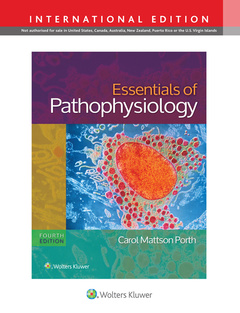Essentials of Pathophysiology (4th Ed., International Edition) Concepts of Altered States
Auteur : Porth Carol

The Fourth Edition builds on the book’s extremely successful art program and the “Understanding” feature and incorporates summary concept boxes after each section. In addition, an expanded, robust, and flexible suite of supplements, including a Study Guide, over 40 advanced 3-D animations, prepU, and Lippincott’s CoursePoint, provide students with all the tools they need to succeed.
Student Resources:
- A fully searchable eBook online is ideal for review on the go.
- Learning Objectives for each chapter provide an outline of key content that must be mastered.
- Journal Articles by chapter, updated for this edition, offer access to current research available in LWW journals.
- Concepts in Action Animations for every chapter help students master key topics.
- New! More than 40 Advanced, 3-D Narrated Animations help students master complex pathophysiological concepts.
- A Spanish-English Audio Glossary provides terms and phrases for communicating with patients in Spanish.
- Monographs of the most commonly prescribed drugs provide up-to-date information.
- 600 NCLEX-style Review Questions help students improve their test-taking skills and prepare for the NCLEX.
- A Dosage Calculations Question & Review Question Bank gives students practice in math skills and calculating drug dosages and reinforce key topics of the course.
Instructor Resources:
- PowerPoint presentations make it easy for you to integrate the textbook with your students’ classroom experience, via either handouts or slide shows.
- Guided Lecture Notes walk you through the chapters, objective by objective, and provide corresponding PowerPoint numbers.
- Discussion Topics (and suggested answers) can be used as a conversation starter or in online discussion boards.
- Assignments (and suggested answers) include group, written, clinical, and Web assignments.
- Case Studies (with related questions and suggested answers) give your students an opportunity to apply their knowledge to a client case similar to what they will encounter in practice.
- Journal Articles, updated for this edition, offer access to research available in LWW journals.
- Answers to Review Exercises in the Book are provided for your convenience.
- Pre-Lecture Quizzes (and answers) are quick, knowledge-based assessments that allow you to check students’ reading.
- Learning Objectives for each chapter allow you to assess your students’ mastery of key skills.
- A QSEN Map demonstrates how the text supports QSEN competencies and their relationship to excellent clinical practice.
- A Sample Syllabus provides guidance for structuring your course.
- Concepts in Action Animations and Advanced 3-D Narrated Animations are provided to enhance your lectures.
To further support your course, the Fourth Edition is accompanied by a Study Guide, prepU, and new to this edition, Lippincott CoursePoint, a digital curriculum solution that integrates adaptive learning powered by prepU with access to personalized, perfectly timed remediation built on trusted content. Each product in the suite can be purchased separately or packaged with the main text.
Introduction to Pathophysiology
Unit 1: Cell and Tissue Function
Chapter 1: Cell Structure and Function
Chapter 2: Cellular Responses to Stress, Injury, and Aging
Chapter 3: Inflammation, the Inflammatory Response, and Fever
Chapter 4: Cell Proliferation and Tissue Regeneration and Repair
Chapter 5: Genetic Control of Cell Function and Inheritance
Chapter 6: Genetic and Congenital Disorders
Chapter 7: Neoplasia
Unit 2: Integrative Body Functions
Chapter 8: Disorders of Fluid, Electrolyte, and Acid-Base Balance
Chapter 9: Stress and Adaptation
Chapter 10: Disorders of Nutritional Status
Unit 3: Hematopoietic Function
Chapter 11: Disorders of White Blood Cells and Lymphoid Tissue
Chapter 12: Disorders of Hemostasis
Chapter 13: Disorders of Red Blood Cells
Unit 4: Infection and Immunity
Chapter 14: Mechanisms of Infectious Disease
Chapter 15: Innate and Adaptive Immunity
Chapter 16: Disorders of the Immune Response
Unit 5: Circulatory Function
Chapter 17: Control of Cardiovascular Function
Chapter 18: Disorders of Blood Flow and Blood Pressure
Chapter 19: Disorders of Cardiac Function
Chapter 20: Heart Failure and Circulatory Shock
Unit 6: Respiratory Function
Chapter 21: Control of Respiratory Function
Chapter 22: Respiratory Tract Infections, Neoplasms, and Childhood Disorders
Chapter 23: Disorders of Ventilation and Gas Exchange
Unit 7: Kidney and Urinary Tract Function
Chapter 24: Structure and Function of the Kidney
Chapter 25: Disorders of Renal Function
Chapter 26: Acute Kidney Injury and Chronic Kidney Disease
Chapter 27: Disorders of the Bladder and Lower Urinary Tract
Unit 8: Gastrointestinal and Hepatobiliary Function
Chapter 28: Structure and Function of the Gastrointestinal System
Chapter 29: Disorders of Gastrointestinal Function
Chapter 30: Disorders of Hepatobiliary and Exocrine Pancreas Function
Unit 9: Endocrine System
Chapter 31: Mechanisms of Endocrine Control
Chapter 32: Disorders of Endocrine Control of Growth and Metabolism
Chapter 33: Diabetes Mellitus and the Metabolic Syndrome
Unit 10: Nervous System
Chapter 34: Organization and Control of Neural Function
Chapter 35: Somatosensory Function, Pain, and Headache
Chapter 36: Disorders of Neuromuscular Function
Chapter 37: Disorders of Brain Function
Chapter 38: Disorders of Special Sensory Function: Vision, Hearing, and Vestibular Function
Unit 11: Genitourinary and Reproductive Function
Chapter 39: Disorders of the Male Genitourinary System
Chapter 40: Disorders of the Female Genitourinary System
Chapter 41: Sexually Transmitted Infections
Unit 12: Musculoskeletal Function
Chapter 42: Structure and Function of the Skeletal System
Chapter 43: Disorders of the Skeletal System: Trauma, Infections, Neoplasms, and Childhood Disorders
Chapter 44: Disorders of the Skeletal System: Metabolic and Rheumatic Disorders
Unit 13: Integumentary Function
Chapter 45: Structure and Function of the Integumentum
Chapter 46: Disorders of Skin Integrity and Function
Glossary
Appendix A: Laboratory Values
Index
Date de parution : 10-2014
Ouvrage de 1280 p.
21.3x27.6 cm
Épuisé
